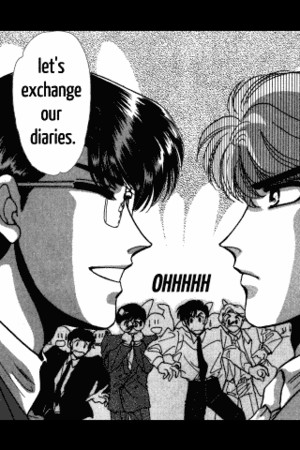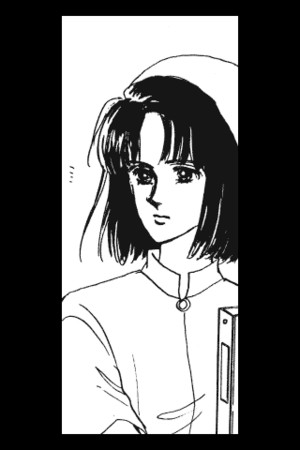Jason Thompson's House of 1000 Manga Special: Combination and Nurse Station
by Jason Thompson,
House of 1000 Manga Special Portable Edition Part 2: Combination and Nurse Station
This is my second week traveling abroad for a family wedding in Amman, Jordan. If you've never been to the Middle East, my best travel advice in one sentence is: you'd better like coffee and tea, ‘cause you'll be drinking a lot of it. Since I love coffee, this is fine with me, and there's more caffeine in a typical cup of Arabic coffee than in the 250ml cans Coke comes in here. The climate in Jordan is a lot like southern California; it rains in the winter, making it wet enough for a few months of green grass before the dry summer sets in. The city of Amman is hilly and busy and, like Tokyo or pretty much anyplace in the world inhabited before cars were invented, is full of narrow streets. There are plenty of American shows subtitled in Arabic on TV, but mostly everyone watches Lebanese TV shows and Egyptian movies. Lebanese comedy shows with male comedians crossdressing as old ladies seem to be the new in thing right now. I got to talk to some people about the protests in Egypt, and the consensus was that the US is hypocritically propping up the dictator Mubarak by saying that he should stay in office for awhile for the sake of “stability” rather than leaving office immediately as the pro-democracy protesters have been demanding. “If Mubarak leaves and isn't replaced by someone else America likes, in a year, America will be invading Egypt in the name of ‘freedom,’” someone said.
Today we had to gather some supplies for the wedding, so we spent the afternoon shopping in Amman's Carrefour megastore, where we found a bunch of very cheap shot glasses (six for a dinar!) made in alcohol-free Saudi Arabia, which probably explains why the glasses were labeled “Executive Juice.” In less religious Jordan, there's no problem filling them with real Executive Juice, and in fact there's quite a few bars and nightclubs around, including one enticingly named “Boozer” (at least I think that's what they mean, since it's spelled “Booser”) not far from my relatives’ apartment. Not that the presence of booze is some sign of high culture, of course—obviously the only real sign of that is MANGA. Sadly, there was little manga to be found apart from the common Arabic-language scanlation sites—but luckily I brought my Magic iPhone filled with (legally) downloaded manga. Like last week, while traveling I've been reading a bunch of manga translated by the cellphone manga company NTT Solmare—sometimes censored, sometimes poorly translated, chopped up panel by panel, but importantly, the most portable manga I could carry. Today, while getting ready for a night of dancing and partying, I found time to read some manga for the iPhone, available for $2.99 per ‘chapter/ for the equivalent of about 30 or 40 pages in print. So enough Livejournal-like autobiographical ramblings and on to the reviews!

Combination is a manga I looked forward to reading, mostly because it's a never-before-translated solo work by Leeza Sei, one of the mangaka who used to belong to the CLAMP collective before they went big. Unfortunately, like Tamayo Akiyama, whose art is very similar, it mostly shows that CLAMP is better off without her. As the English-language title suggests, it's a buddy story— the tale of a “combination” of two cops, whose suggestive relationship gives the reason why this PG-rated story is considered Boy's Love by its fans.
Sasaki, a 22-year-old elite graduate of CLAMP University, is a rookie cop partnered up with Hashiba, a 26-year-old goof-off. Both of them are apparently nine feet tall and have four-foot-wide shoulders, and their angular faces have too much screentone on them. (Someone, not me, needs to write a history of the types of screentone used in manga; the excessive tone used in Combination screams early 1990s and makes me wonder if screentone companies were pushing gradated tones at that time.) Sasaki, the perfectionist son of a police commissioner, does the paperwork and first aid; Hashiba has parties in the office, cracks jokes and, when they first start working, suggests that he and Sasaki exchange diaries so they can get to know each other better. But his wacky exterior conceals his true brooding nature; he's really a badass gunman with a death wish who's tracking down the evil Shudo Mafia crime syndicate.
“The very reticent person like Sasaki and the never-serious Hashiba, it's really surprising to me that they are still working as a team,” think their coworkers, and there you have the entire manga in one sentence. The plot is basic. In a typical scene, Hashiba is getting cash from the ATM, that exciting futuristic machine, when criminals show up to rob the bank. He and Sasaki whip out their guns and catch the bank robbers, although their apparent lack of interest in the whole thing might just be due to a shortage of exclamation points. (“Oh…hey, you. To run away is what only cowards do.”) Their old fuddy-duddy boss back at the police station is always mad at them for Hashiba's shenanigans. (“It is correct to arrest! But I'm saying you did it too much! You gotta apology letter!”) Sasaki, the narrator, finds himself curiously obsessed with his partner and ponders their relationship in endless screens of barely-translated internal monologues. (“Even though there is something attracting me, there's no reason that I want to know something about him or to do for it…by seeing that Hashiba, always laughing, joking and speaking unseriously…I figured out that was the poker face not to show sincere himself.”) In return for his concern, Hashiba mocks Sasaki by calling him a “goody.” Hashiba's chief informant is Yakko-chan, a little girl, who gives him tips on the Shudo Mafia while eating parfaits at the coffeeshop. At times Combination is so bad it's worth a tongue-in-cheek read, but for lovers of sexy men with guns, there's more adult thrills to be found in Fake and Yellow. Here, the man-to-man is limited to lightly flirty dialogue, while the mediocre art and (lack of) plot would make you throw your phone across the room if you were reading it as a straight (pun intended) crime story. Also, it's a pain to read on the phone due to all the long vertical and horizontal panels. It's only for the true CLAMP completist or early-1990s manga masochist.

In contrast to the fangirly Combination, Kyoko Shimazu's Nurse Station is a serious, adult josei manga. Like many josei, it's about the balance between professional and personal lives, in this case about twentysomething nurses at a hospital. Each story focuses on a different nurse from the same staff. Keiko, the heroine of the first story, left her small-town home nine years ago, leaving behind a man who loved her, as well as her housewife mother, who Keiko despised for her helplessness. (“Mom, I won't be like you. I don't want to be a weak woman with nothing special about her.”) Now she's in the big city, having an affair with a married man and working long hours at the hospital, coming home from the night shift just in time to crash out on her bed. Full of mixed feelings about her job, wanting to be independent but not wanting to be used, she takes pleasure in being able to help people: a crotchety old man, a sickly little boy, not to mention that handsome patient who survived the tragic car accident that killed his girlfriend. “I know how you feel, but if you stick your nose into their private lives, things can turn nasty,” a coworker warns her, but the job has its good side too. “Isn't it nice to see people leave here with smiles like that on their faces?”
Riho, the curly-haired young heroine of the second story, isn't as outwardly competent as Keiko, and her nursing life is full of (mostly) humorous mishaps, bedpan accidents and getting chewed out by her boss. (“Excuses and carelessness will do you no good in this line of work. Are you sure your inner negligence hasn't begun to show in your appearance as well?”) Unlike Keiko, she's in a happy relationship, and in her case, the big question is whether she'll stop nursing when her boyfriend offers to support her. “You're just too irresponsible. I know your type. You get into this profession just because you like the idea of ‘being a nurse,’” her arrogant coworker chides her. “I'd always admired Florence Nightingale and the ‘angels in white coats,’” Riho thinks. But, like Keiko, she too gets the opportunity to save a life through her patient nursing, and learns to appreciate her job. And so on for multiple chapters and multiple nurses.
Nurse Station is a manga about tears; where other manga have romantic sparkles or blooming flowers, every chapter of Nurse Station at some point involves copious self-doubt and weeping. At some points the drama is a little too thick; Keiko's story of a dying boy neglected by his parents is a little too much to take seriously. But there's usually a rainbow after the storm lest it get too depressing, and the anthology format means that each chapter (each app) is a standalone story, adding up to a lot of variety. For fans of josei manga like With the Light, it's worth checking out. Actually, one of the best aspects of Nurse Station compared to most other NTT Solmare manga, is that it's one of the few to have a professional translation. After slogging through the word salad of Combination and Salaryman Kintaro, I rediscovered my appreciation for normal-sounding dialogue.
The last manga I read this time around is Yasuichi Oshima's Police Rocker Bofura, which reads like an old one-shot from the back of Raijin Comics, for those who read that ancient curiosity. The gimmick: Tamari Bunta is a five-foot-tall punk rocker who's also an undercover policeman. He lives in a crappy apartment with a yakuza for a neighbor when not fronting his unpopular band “Bofura.” He appears to do no police work or to have any talents whatsoever, until suddenly he rescues this girl from a bunch of jerks and the very short first chapter of the manga abruptly ends. The best thing about reading this manga is the panel when Bofura is on stage singing a song called “Cocky Cocky Kock,” which made me want to see the original Japanese version to see what the hell he was actually singing in the original. (“Wasn't your COCKY KOCK [sic] disgusting?” one of his fellow band members asks him after the show. “Maybe…probably the message was too strong,” Bofura admits.) Also, the old-fashioned shonen manga art is nice and detailed. But still, it wasn't enough to make me want to pay another $2.99 to keep reading this dopey manga. It's one of those manga where, if you hear the title, you've essentially read it already.
That's all for this month's short travel edition of House of 1000 Manga. Stay tuned for next week as I head to the Amman Starbucks (Venti Mocha, 2.95 dinars) to try to find the precious WiFi collection where I can download still more manga without paying international roaming charges!
Jason Thompson is the author of Manga: The Complete Guide and King of RPGs, as well as manga editor for Otaku USA magazine.
Banner designed by Lanny Liu.
discuss this in the forum (2 posts) |